
The giant planet J1407b has been a weird space mystery since its discovery in 2010. But a new study revealed something about the planet that may help explain at least part of its weirdness: a sprawling set of rings that may actually rotate backwards around the planet.
J1407b may be a rogue planet, drifting through space untethered to a star or other planets, or it may be orbiting nearby star V1400 Centauri on a wide loop that astronomers haven’t mapped yet. Either way, it’s home to wide rings and a handful of moons, one of which may be as large as our whole planet. Those rings and moons may actually be in a retrograde orbit, meaning they revolve backwards around the planet. A recent study used computer simulations to explain how that might happen.
Wenshuai Liu, a physicist at Henan Normal University in China, published his work in a preprint paper which has not yet been peer-reviewed.

A Rogue Planet with Backwards Rings?
Liu simulated how a giant planet and its ring system might form and evolve around a star like V1400 Centauri, which is about the mass of our Sun but a few billion years younger. Their models suggest that as giant planets coalesce out of the gas and dust swirling around the star, interactions between those planets can not only nudge some of them into weird, stretched-out orbits, but also set their rings spinning in the wrong direction.
If Liu is right, that might explain not only why J1407b’s rings may rotate backwards, but why they exist at all.
In 2007, J1407b happened to pass between Earth and the star V1400 Centauri blocking part of the star’s light. Astronomers didn’t spot the planet’s shadow in the data from the Super Wide Angle Search for Planets until three years later, but once they did, the planet quickly became a fascinating puzzle. For one thing, it’s large enough to be a brown dwarf, a massive object too big to be a mere gas planet, but not quite big enough to be a star.
The planet’s silhouette revealed that it has a system of dusty rings and moons about 200 times wider than Saturn’s rings. Gaps between the rings mark where moons have cleared lanes through the dust (even though they can’t see the moons themselves; we haven’t yet imaged an exomoon, or a moon orbiting a planet outside our Solar System). Based on the width of the lane it’s cleared between rings, one of those moons may be at least the size of Earth.
If J1407b really is a rogue planet, at least it’s not completely alone out there.
And then there’s the really weird part: the possibility that J1407b may not be orbiting V1400 Centauri, but instead a solo traveler that just happened to pass through the 450 light years of space between the star and Earth. Because it hasn’t crossed in front of the star again since 2010, and because a survey with ALMA in 2017 spotted it in a position it shouldn’t have been in if it were actually caught in the star’s gravity, some astronomers argue that J1407b is more likely to be a rogue planet than a companion to V1400 Centauri. The puzzle isn’t entirely solved, because a 2019 survey didn’t find any sign of J1407b at all.
Part of the debate about J1407b centers on the fact that if it’s really in a wide orbit around the star, then the planet shouldn’t be able to hang onto the more distant reaches of its system of rings and moons. Instead, the star’s gravity should strip them away every time its orbit swoops close by (about 5 times the distance from Earth to the Sun, at its closest approach, if earlier studies are correct). That’s part of what Liu hoped to explain with his simulations.
It turns out that, for reasons that have to do with the detailed physics of flowing dust clouds in space, a ring orbiting backwards around its planet is a little more stable than one orbiting in the same direction the planet rotates. Another team of astronomers suggested back in 2016 that if J1407b’s ring system rotated backwards, it could hold out against the gravitational tug of V1400 Centauri. But no one could actually explain why the ring system would happen to rotate backwards, and that’s been a sticking point for the whole argument in support of J1407b orbiting V1400 Centauri instead of going rogue.
According to Liu’s simulations, as giant planets coalesce out of the gas and dust swirling around the star, the newly-forming planets’ gravity pushed and pulled at one another, jostling the young planets into different orbits — something very similar to the kind of gravitational nudging that sent Jupiter migrating inward during the turbulent early years of our own Solar System. Along the way, J1407b got herded into a long, narrow orbit. The complex ways fluids (including flowing clouds of dust in space) interact eventually caused the planet’s little disk of material to start flowing, or orbiting, in the opposite direction from the planet’s rotation and its path around the star.
We won’t know for sure unless astronomers can capture a direct image of the planet, and that’s no small feat, since they’d have to find it again first.







